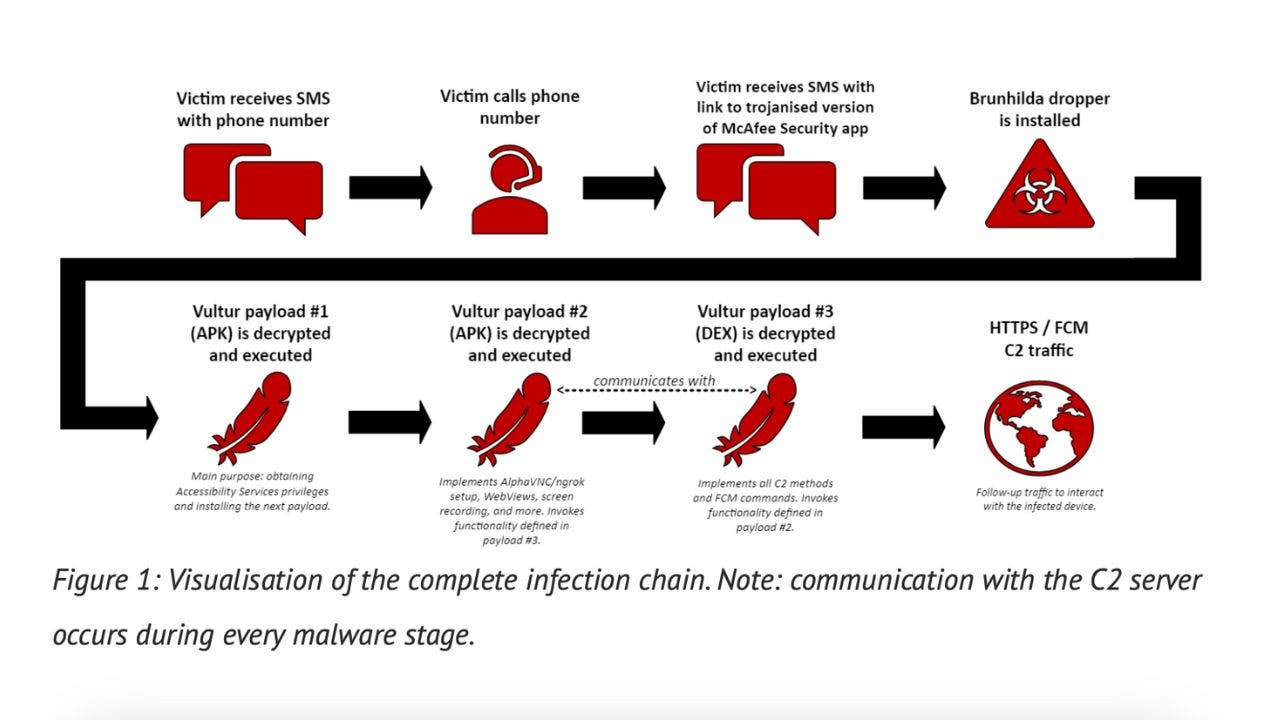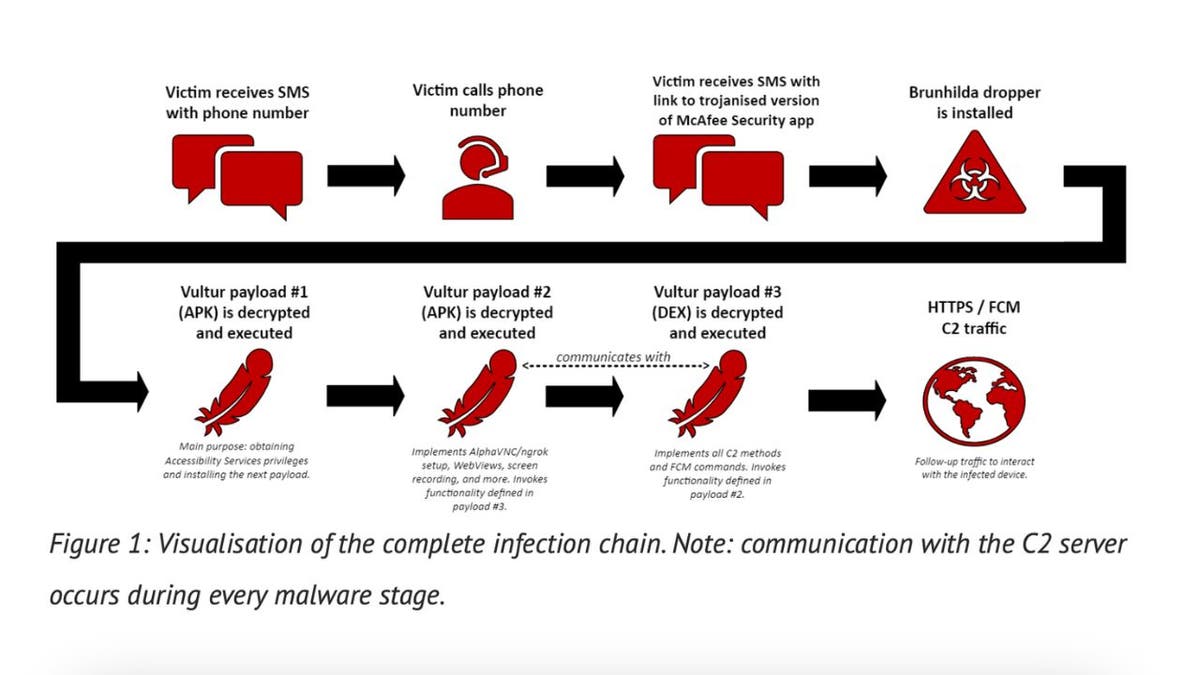Technology
Protect your Android from the Vultur banking Trojan’s remote attacks

One of the most advanced Trojans targeting banking apps has gotten an upgrade. Vultur has been wreaking havoc on Androids since security firm ThreatFabric discovered it in 2021. According to researchers with NCC Group, the malware has reemerged and is even stealthier than before.
You might remember Vultur for the notoriety it gained for its ability to screen record on devices remotely. It hid in apps, some of which were on the Google Play Store, and infected your device.
But now Vultur has new ways to take over Androids and new methods to trick you into downloading malware. Hackers now utilize everything from text messages to phone calls to dupe their victims. Once they get into your device, they can take total control. Hackers can remotely access and use your phone – all in an effort to take your hard-earned money.
CLICK TO GET KURT’S FREE CYBERGUY NEWSLETTER WITH SECURITY ALERTS, QUICK VIDEO TIPS, TECH REVIEWS AND EASY HOW-TO’S TO MAKE YOU SMARTER
Android phone (Kurt “CyberGuy” Knutsson)
Vultur’s new hybrid attack
According to NCC Group, this new attack focuses on contacting victims. It begins with a text message urging the victim to call if they didn’t authorize a transaction on their bank account. However, the transaction isn’t real; it’s simply a ruse.
If the victim calls, they will receive instructions to download a McAfee Security app containing the banking Trojan and a text message with the link.
The security app looks normal but actually contains the Brunhilda dropper, a deceptive component hidden within seemingly legitimate apps. In this case, the dropper contains the Vultur Trojan. It then releases and executes the Trojan in three batches. When the third batch is dropped, hackers can gain total control of your Android device.

Illustration of infection chain (NCC Group) (Kurt “CyberGuy” Knutsson)
MORE: HACKERS USE PIRATED SOFTWARE TO HIJACK MAC, ANDROID, WINDOWS DEVICES
Vultur’s new features
Vultur was already a very serious threat to Android users. But now, that threat has been significantly upgraded thanks to the level of control hackers can gain. Once Vultur has infected your device, hackers can install, delete, upload and download files. It can even stop apps from running in the first place. If that wasn’t enough, Vultur can bypass Android’s Keylock feature, bypassing your lock screen.
Even more frightening is Vultur’s remote control capabilities. The malware has been able to remotely access devices since it was first discovered in 2021. But now, hackers can instruct the malware to swipe, click, scroll, mute and unmute audio, and more, giving them more control.
Hackers don’t need to worry about staying connected to the device, either. They have leveraged Google’s Firebase Cloud Messaging system to be able to send instructions to infected devices.

Samsung phone (Kurt “CyberGuy” Knutsson)
How to protect your Android from Vultur
One of the biggest ways to stay away from Vultur is not to call after a hacker texts you about approving a large bank transaction. You can always call your financial intuition yourself to check. But never call an unknown phone number that’s sent to you by an unknown person. Here are some other tips as well:
Avoid sideloading apps and shortened URLs
Try not to sideload apps. That’s when you install apps outside of a legitimate source. Shortened URLs can mislead users into downloading malware.
Be careful granting permissions
Exercise caution when granting app permissions. Consider whether an app truly needs access to certain device functions or data.
Limit the apps you have on your phone
Sometimes, having a lot of apps on your phone can make it easy to be exposed to malware. These apps can let in malicious code over time, and the more apps you have to keep track of and update, the more likely your Android will be vulnerable. Here’s how to delete unnecessary apps from your Android.

Hacker using Android and laptop (Kurt “CyberGuy” Knutsson)
MORE: WHAT YOU NEED TO KNOW ABOUT VAJRASPY RAT, THE CYBERESPIONAGE TOOL THAT INFILTRATED GOOGLE PLAY
Download apps from reputable sources
Additionally, when you download apps, make sure they are from reliable and legitimate developers. Check reviews and do some research before just hitting “install.”
Keep your Android device updated
Your phone has a way of keeping itself safe with software and security updates. Don’t forget to install them.
Have good antivirus software on all your devices
Installing antivirus protection on all your devices is the best way to protect yourself from malware. Antivirus software will prevent you from clicking on potentially malicious links that may install malware on your devices, allowing hackers to gain access to your personal information. Get my picks for the best 2024 antivirus protection winners for your Windows, Mac, Android & iOS devices.
What should you do if your data is compromised?
If malware has already invaded your device, then you should take immediate action to minimize the damage and secure your device. Here are some steps that you can follow:
Change your passwords
Vultur can give hackers access to everything on your device, including your online accounts and your personal or financial information. To prevent this, you should change your passwords for all your important accounts as soon as possible. However, you should not do this on your infected device because the hacker might see your new passwords. Instead, you should use ANOTHER DEVICE, such as your laptop or desktop, to change your passwords. Make sure you use strong and unique passwords that are difficult to guess or break. You can also use a password manager to generate and store your passwords securely.
Monitor your accounts and transactions
You should regularly check your online accounts and transactions for suspicious or unauthorized activity. If you notice anything unusual, report it to the service provider or authorities immediately. You should also review your credit reports and scores to see signs of identity theft or fraud.
Use identity theft protection
Hackers can access everything on your Android device, including your personal and financial information. They can use this information to create fake accounts in your name, access your existing accounts and pretend to be you online. This can cause serious damage to your identity and credit score.
To avoid this, you should use identity theft protection services. These services can track your personal information, such as your home title, Social Security Number, phone number and email address, and notify you if they detect any suspicious activity. They can also help you freeze your bank and credit card accounts to stop hackers from using them. Read more of my review of the best identity theft protection services here.
Contact your bank and credit card companies
If hackers have obtained your bank or credit card information, they could use it to make purchases or withdrawals without your consent. You should inform your bank and credit card companies of the situation. They can help you freeze or cancel your cards, dispute any fraudulent charges and issue new cards for you.
Alert your contacts
If hackers have accessed your email or social media accounts, they could use them to send spam or phishing messages to your contacts. They could also impersonate you and ask for money or personal information. You should alert your contacts and warn them not to open or respond to any messages from you that seem suspicious or unusual.
Restore your device to factory settings
If you want to ensure that your device is free of malware or spyware, you can restore it to factory settings. This will erase all your data and settings and reinstall the original Android version. Before doing this, you should back up your important data and only restore it from a trusted source.
Kurt’s key takeaways
Vultur is an incredibly sophisticated banking Trojan with some terrifying features. The fact that hackers can gain full control of your Android is scary, making it all the more important that you protect yourself.
These attacks begin with a simple text message. It’s up to you to make the effort to separately call your financial institution and see if anything’s amiss. Just taking an extra 10 minutes can save you from having your entire device compromised and your personal information exposed.
How worried are you about Vultur attacks? How do you protect yourself from attacks targeting your finances? Let us know by writing us at Cyberguy.com/Contact.
For more of my tech tips & security alerts, subscribe to my free CyberGuy Report Newsletter by heading to Cyberguy.com/Newsletter.
Ask Kurt a question or let us know what stories you’d like us to cover.
Answers to the most asked CyberGuy questions:
Copyright 2024 CyberGuy.com. All rights reserved.

Technology
Amazon says its Prime deliveries are getting even faster
/cdn.vox-cdn.com/uploads/chorus_asset/file/23935559/acastro_STK103__02.jpg)
To me, Prime’s promise of two-day shipping is more of an added bonus to Prime Video and stuff like Fallout. But it’s become an expectation, leading other retailers like Walmart and Target to roll out faster shipping options of their own.
Now, Amazon says its deliveries are getting even faster, announcing that it delivered over 2 billion items the same or next day to Prime members during the first three months of 2024, breaking its record for 2023. The company says it delivered almost 60 percent of Prime orders the same or next day in 60 of the biggest metropolitan areas in the US.
If you buy from Amazon, have you noticed any differences lately? Same-day and next-day options seem to be more widely available, but it’s hard to tell how that applies to different items in different places or whether the associated costs are worth it based on reports of warehouse injuries and workers organizing for better conditions.
The control Amazon has over shipping and fulfillment has helped make it the target of a lawsuit from the Federal Trade Commission. The agency alleges Amazon engages in anticompetitive behavior by unfairly limiting which sellers are eligible for Prime shipping and coercing companies into using its fulfillment services. Amazon claims that the FTC’s efforts could result in “slower or less reliable” Prime shipping for customers.
In 2019, Amazon said it was spending billions to build up an in-house fulfillment operation covering planes, trucks, drones, and robots to rival FedEx and UPS and enable these one-day-or-less deliveries. And last year, it introduced a program that allows sellers to ship their products directly from factories — regardless of whether they’re going to one of Amazon’s many warehouses.
Technology
How ‘Yahoo Boys’ use real-time face-swapping to carry out elaborate romance scams

We’ve all heard of catfish scams – when someone pretends to be a lover on the other side of the screen, but instead, they aren’t who they say they are once their real face is revealed. Now, there’s a similar scam on the rise, and it’s much more sophisticated because scammers can fake the face, too. The scam is known as the “Yahoo Boys” scam, and it’s taking “catfishing” to a whole new level.
CLICK TO GET KURT’S FREE CYBERGUY NEWSLETTER WITH SECURITY ALERTS, QUICK VIDEO TIPS, TECH REVIEWS AND EASY HOW-TO’S TO MAKE YOU SMARTER
Woman on laptop making a heart sign (Kurt “CyberGuy” Knutsson)
How does deepfake technology work?
Deepfake technology uses AI to allow people to impersonate others over audio or video. The technology is essentially able to replicate someone’s face, facial expressions, gestures, voice, etc., so that the scammer can pretend to be someone they aren’t with almost perfect accuracy. Although deepfake technology has some intentions for good – like in the film industry or advertising (though there are some debates regarding the ethics of this) – it’s generally used for more malicious purposes than anything else.
Because it’s very difficult to tell whether or not a deepfake is the real person or a deepfake (and also because deepfakes are relatively new), deepfakes can have the potential to do a lot of damage. From the larger implications of it being used to spread inaccurate news stories that can sway public opinion and political processes to it being used to inflict damage on individuals with scams, it’s important to know what to watch out for.

Woman with a scan on her face (Kurt “CyberGuy” Knutsson)
MORE: EXPOSING THE TOP SCAMS TARGETING COSTCO SHOPPERS
What is the ‘Yahoo Boys’ scam?
The “Yahoo Boys” scam involves a group of sophisticated cybercriminals, primarily based in Nigeria, who are using this technology to conduct what’s otherwise known as romance scams. Like some catfishing attempts, they first build trust with victims through personal and romantic interactions over messaging and, eventually, video calls, where they then manipulate their appearances in real time to match the description and profile they may have shared with them up until that point.
By doing this, they can trick the victim into trusting them even more. This is because most of us still use video as a way to verify a person’s identity, when messaging isn’t convincing enough. Finally, when the timing is right, the victims are often persuaded into transferring money based on various fabricated scenarios, leading to significant financial losses. In fact, the FBI reported over $650 million lost to romance scams like these.

Man on his cellphone (Kurt “CyberGuy” Knutsson)
MORE: DON’T FALL FOR THESE SNEAKY TAX SCAMS THAT ARE OUT TO STEAL YOUR IDENTITY AND MONEY
How does it actually work?
In the case of the “Yahoo Boys” scam, the scammers do their dirty work by:
Step 1: The scammer will use two smartphones or a combination of a smartphone and a laptop. One device is used to conduct the video call with the victim, while the other runs face-swapping software.
Step 2: On a secondary device, the scammer activates face-swapping software. This device’s camera films the scammer’s face, and the software adds a digital mask over it. This mask is a realistic replica of another person’s facial features, which the scammer has chosen to impersonate. The software is sophisticated enough to track and mimic the scammer’s facial movements and expressions in real time, altering everything from skin tone and facial structure to hair and gender to match the chosen identity.
Step 3: For the video call, the scammer uses a primary device with its rear camera aimed at the secondary device’s screen. This screen shows the deepfake – the digitally altered face. The rear camera captures this and sends it to the victim, who sees the deepfake as if it’s the scammer’s actual face. To make the illusion more convincing, the devices are stabilized on stands, and ring lights provide even, flattering lighting. This setup ensures that the deepfake appears clear and stable, tricking the victim into believing they’re seeing a real person.
Step 4: Throughout the call, the scammer speaks using their own voice, although in some setups, voice-altering technology might also be used to match the voice to the deep-faked face. This comprehensive disguise allows the scammer to interact naturally with the victim, reinforcing the illusion.
Though each deepfake scam is different, having a basic level of understanding in terms of how scams like these work can help you recognize them.

Scammer typing on a keyboard (Kurt “CyberGuy” Knutsson)
How to stay safe from deepfake scams
To protect yourself from deepfake scams like the “Yahoo Boys” scam, here’s what you can do:
Verify identities: Always confirm the identity of individuals you meet online through video calls by asking them to perform unpredictable actions in real time, like writing a specific word on paper and showing it on camera.
Be skeptical of unusual requests: Be cautious if someone you’ve only met online requests money, personal information or any other sensitive details.
Enhance privacy settings: Adjust privacy settings on social media and other platforms to limit the amount of personal information available publicly, which can be used to create deepfake content.
Use secure communication channels: Prefer secure, encrypted platforms for communications and avoid sharing sensitive content over less secure channels.
Educate yourself about deepfakes: Stay informed about the latest developments in deepfake technology to better recognize potentially manipulated content.
Report suspicious activity: If you encounter a potential scam or deepfake attempt, report it to the relevant authorities or platforms to help prevent further incidents.
By following these guidelines, you can reduce your risk of falling victim to sophisticated digital scams and protect your personal and financial information from falling into the hands of these scammers.

Woman talking on her cellphone (Kurt “CyberGuy” Knutsson)
MORE: CAN AI HELP SOMEONE STAGE A FAKE KIDNAPPING SCAM AGAINST YOUR FAMILY
Protecting your identity in the age of deepfakes
As deepfake technology becomes more accessible and convincing, the risk of identity theft increases. Scammers can use stolen personal information to create more believable deepfakes, making it harder for you to detect fraud. Furthermore, the sophistication of deepfakes may allow criminals to bypass biometric security measures, potentially granting them unauthorized access to your personal accounts and sensitive financial information. This is where identity theft protection services become invaluable.
Identity Theft companies can monitor personal information like your Social Security Number, phone number and email address and alert you if it is being sold on the dark web or being used to open an account. They can also assist you in freezing your bank and credit card accounts to prevent further unauthorized use by criminals.
One of the best parts of using some services is that they might include identity theft insurance of up to $1 million to cover losses and legal fees and a white-glove fraud resolution team where a U.S.-based case manager helps you recover any losses. See my tips and best picks on how to protect yourself from identity theft.
By subscribing to a reputable identity theft protection service, you can add an extra layer of security, ensuring that your digital presence is monitored and protected against the ever-evolving tactics of cybercriminals like the “Yahoo Boys.”
MORE: UNFORGETTABLE MOTHER’S DAY GIFTS 2024
Kurt’s key takeaways
The main targets of the “Yahoo Boys” scam are individuals who establish online romantic relationships with the scammers. Because these victims are often emotionally invested and therefore more susceptible to manipulation, there’s not necessarily a specific age or demographic that can become a victim. And because we know the root of all these scams is the deepfake technology, truly anyone can become a target. So, we hope this helps, but also, be sure to spread the word to friends and family.
Have you heard of any other types of deepfake scams? Or do you know anyone who has been a victim of scams like this? Let us know by writing us at Cyberguy.com/Contact.
For more of my tech tips & security alerts, subscribe to my free CyberGuy Report Newsletter by heading to Cyberguy.com/Newsletter.
Ask Kurt a question or let us know what stories you’d like us to cover.
Answers to the most asked CyberGuy questions:
Copyright 2024 CyberGuy.com. All rights reserved.
Technology
Financial Times signs licensing deal with OpenAI
/cdn.vox-cdn.com/uploads/chorus_asset/file/25362057/STK_414_AI_CHATBOT_R2_CVirginia_B.jpg)
The Financial Times has struck a deal with OpenAI to license its content and develop AI tools, the latest news organization to work with the AI company.
The FT writes in a press release that ChatGPT users will see summaries, quotes, and links to its articles. Any prompt that returns information from the FT will be attributed to the publication.
In return, OpenAI will work with the news organization to develop new AI products. The FT already uses OpenAI products, saying it is a customer of ChatGPT Enterprise. Last month, the FT released a generative AI search function on beta powered by Anthropic’s Claude large language model. Ask FT lets subscribers find information across the publication’s articles.
Financial Times Group CEO John Ridding says that even as the company partners with OpenAI, the publication continues to commit to “human journalism.”
“It’s right, of course, that AI platforms pay publishers for the use of their material,” Ridding says. He adds that “it’s clearly in the interests of users that these products contain reliable sources.”
-

 Kentucky1 week ago
Kentucky1 week agoKentucky first lady visits Fort Knox schools in honor of Month of the Military Child
-

 World1 week ago
World1 week agoShipping firms plead for UN help amid escalating Middle East conflict
-

 News1 week ago
News1 week agoIs this fictitious civil war closer to reality than we think? : Consider This from NPR
-

 Politics1 week ago
Politics1 week agoICE chief says this foreign adversary isn’t taking back its illegal immigrants
-

 Politics1 week ago
Politics1 week ago'Nothing more backwards' than US funding Ukraine border security but not our own, conservatives say
-

 News1 week ago
News1 week agoThe San Francisco Zoo will receive a pair of pandas from China
-

 World1 week ago
World1 week agoTwo Mexican mayoral contenders found dead on same day
-

 Politics1 week ago
Politics1 week agoRepublican aims to break decades long Senate election losing streak in this blue state















